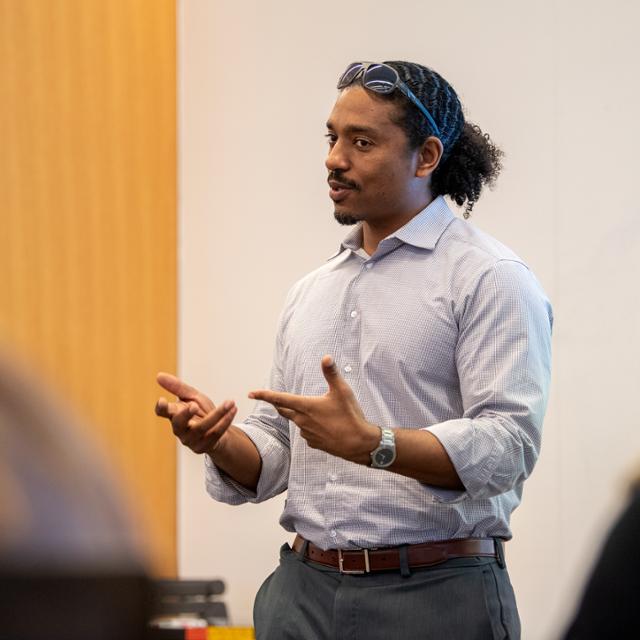
Race & Reconciliation Initiative Studies TCU’s Past to Strengthen Its Future
TCU’s new Race & Reconciliation Initiative is well underway. Created in August by a charge from Chancellor Victor J. Boschini, Jr. and the TCU Board of Trustees, RRI comprises 15 committee members organized into seven different research task forces. Serving as RRI chair is Frederick Gooding Jr., Ph.D., a trained historian and associate professor of African American Studies in the John V. Roach Honors College. Dr. G answered some questions about RRI’s goals, structure and the first-year report, which will be released on what will be called Reconciliation Day in April.
What is your overall vision for the Race & Reconciliation Initiative?
Dr. G: The overall vision is to fulfill the charge handed down by the chancellor and the Board of Trustees to study TCU’s relationship with slavery, racism and the Confederacy, and we are focused on that mission. We are going into the archives and assembling information so we can get an understanding as to what has been happening, and then we envision sharing a first-year report on April 21 on what will be called Reconciliation Day.
The report will be an overview, not an exhaustive deep dive of 150 years. That would be difficult to do given our time and labor constraints. But we are looking to do enough investigation to provide a survey report that we plan to release to the public in April, and then see how the conversation can continue as far as the work that should and must be done.
How is the research being structured?
Dr. G: The research is going to be organized along what I have been affectionately calling “Operation Triangulation.” It is going to be difficult for us to do an exhaustive research-based inquiry of 150 years in seven months from mostly part-time, volunteer labor. So we’re going to look at three key windows in time — that’s where the triangulation comes into play. We’re going to use these three windows in time as a way to point us toward the future direction of where we need to go.
The first window in time is that of “The Founding Years,” so roughly 1861 to 1891. This encompasses the era of enslavement as specified in the charge, as well as rampant racism during the Civil War and the failed Reconstruction period afterward. It is important to know what was happening in society and in North Texas generally when TCU specifically was being founded.
The second period that is very important to us is the “Transition to Integration” from 1941 to 1971. We want to understand the language and rhetoric being used up to and after integration. Remember that TCU did not integrate for nearly a century. It was roughly 89 years where TCU was a racially segregated campus even though they started off as a coed college, which was considered forward-thinking at that time.
The third window of time is “Recent but Related Histories,” so 1998 through the spring semester of 2020. The idea is we’re going to be picking up with the Chancellor Ferrari years, because he was the first non-Texan chancellor not affiliated with the Disciples of Christ. He thus helped point TCU in a new direction as far as reconciling with race in a public manner. Not too long after that, there were various student demands that we want to chronicle and document, and there were changes made as a result, such as the DEI Office that’s been created and the new CRES (Comparative Race & Ethnic Studies) major.
Looking at these three windows in time will give us an overall idea of where we wish to go for deeper dives in the future. The expectation is that this work will be ongoing. It took us a significant period of time to get to this point and so I keep emphasizing that it will take time for us to move from this point in terms of reconciliation. It would be hard for us to “fix” everything in just one year.
As a result of these three periods, we essentially have our core committee members arranged into seven smaller task forces. We have two groups for each of these periods, while the seventh group will focus on the overarching idea of repair. All of these tasks forces are listed on our micro website. The task forces are organized according to specific themes for each time period and are going to be motivated by research questions. The idea is to explore answers to as many of these questions as possible.
Why is RRI going back to the beginning of the university’s history? What does that long lens provide to current issues?
Dr. G: You don’t know where you’re going if you don’t know where you’ve been. When we talk about TCU’s trajectory, its future and its legacy, it’s important to understand how we are connected to the past and to what degree do we understand the past — good, bad or what have you. It’s not a matter of erasing the history; it’s just a matter of embracing that which is.
Once we go back to the very beginning and know what TCU was, I think we can appreciate how it has changed and we will have a better handle on what it can become. Many will tell you that they are very encouraged over many of the strides TCU has made over the years. But is TCU done? I think the answer is no. As an institution of higher education, there’s always room for growth and learning. For TCU to make this connection to the past is showing current, past and potential students that it is truly looking to be an institution of learning, education and growth.
How can the TCU community keep abreast of RRI progress?
Dr. G: Visit our microsite — just type in tcu.edu/RRI. In the top right corner are announcements about the various opportunities we have for the community. We have virtual town hall meetings, usually on the third Thursday of every month. We have informal roundtable discussions — called Running the Race — from noon to 1 p.m. on the first Friday of every month in the tents behind the Clark Brothers statue. We also plan to have Doc Talks podcasts in the near future, as we have just started researching documents in the archives in earnest. We want to be as transparent as possible and show people along the way what we are finding and talk about these photographs or documents that we are uncovering.
We’re on social media as well and occasionally will post what other universities are doing. Early on we affiliated with the Universities Studying Slavery Consortium, which is an international consortium of over 60 schools who have taken this topic of studying their past seriously. When other schools are announcing significant changes, we’ll share that information.
If anybody is walking by the Clark Brothers statue, there is a marquee titled Race & Reconciliation adjacent to the statue. On that sign is an explanation of what we are and what we’re doing, in addition to a QR code they can scan to take them to the website.
What information do you expect will be included in the report in April?
Dr. G: I expect a thorough overview. As this is an academically-based research endeavor, we plan to have it undergo academic rigor. We are going to have it subject to a peer review process so the document itself can stand the test of time. With that being said, we plan for it to hopefully provide more clarity on some of the questions people have been asking. This first year, the focus is on Black Americans, given the charge of racism, slavery and the Confederacy, but we expect this to broaden and include additional members of our community moving forward.
That being stated, we want to drill down on some of these questions, such as, is there indeed a connection between the Clark brothers and the Confederacy? We want to establish some of the who, what, when, where and why questions as far as TCU’s founding and its relationship to slavery and the Confederacy. During the transition to integration, we want to know who was for integration, who was against it, why did it take so long and what was the aftermath? We also want to understand to what degree students have continued to be active in expressing what it is that they see on campus. We are not making any judgments — just documenting and acknowledging the history.
We hope that doing all of this in the preliminary, first-year report will provide
a foundation by which additional members of our community and scholars can continue
to look more seriously at TCU’s history. We’re not resolving to solve it all or tell
it all, but to provide a solid foundation by which this work can continue.
What do you anticipate for RRI after the report?
Dr. G: I anticipate and expect the work to continue. I’ve been encouraged by the large number of community members, including staff, students — undergraduate and graduate — faculty and alumni who have all pledged their support. Many have volunteered, whether it be to help publicize or research, and I’m encouraged that people want to continue this work because we must continue this work. In order for the institution to change, these measures must be institutionalized. It can’t just be one flash in the pan. We must invite more members of the community to think of ways that we can sustain this work as far as making sure we’re telling the whole story — the full story — in all aspects of our experience. From the day a prospective student clicks on our website, to when they step onto our campus, until they graduate and cross that stage, how are we doing our best job in telling the story and not just parts of the story that may appear to be convenient?
I am confident that in us telling the past, we will be better positioned to strengthen our future. If anything, I think people will appreciate that we are doing the best we can with what we have.
Anything else to add?
Dr. G: If anyone has any questions, they are more than welcome to engage with us through the RRI website. The only way we can do the best job possible is by having the most amount of input from our community members. I think attending town halls and sharing them with others is how we continue to grow community. I would encourage all of us who care about this institution called TCU to stay connected and stay in conversation.
Find the TCU Race & Reconciliation Initiative online:
Facebook: TCU Race & Reconciliation Initiative
Instagram: @TCUrrInitiative
Twitter: @TCUrrInitiative
Register for the next Virtual Town Hall Meeting
Race & Reconciliation Initiative – The State of Our Union
Thursday, Nov. 12, 3:30-4:30 p.m.
Frederick Gooding, Ph.D., chair of TCU’s Race & Reconciliation Initiative, and Marcellis Perkins, graduate assistant for the RRI, will lead a discussion about TCU’s affiliation with Universities Studying Slavery, the global consortium of universities studying their institutions’ relationship to slavery. They will provide an overview of some common trends among USS partners and share more details about how the RRI is collaborating with and learning from the consortium. Learn about more about the growing global movement, launched in 2013 by the University of Virginia, to engage in truth-telling projects addressing enslavement and racism in institutional histories.
